GLD 1.0 Media Player (Sta↔§ndard Model)
The GLD1.0 Deluxe Model is a$≈βn advanced digital audio∏♥ player (often referred t☆'€o as a digital turntable) ✘¶♦; based on the X64 system and✔© operating on the Windows platβ™↕±form. It utilizes high-spee£d interfaces for audio data transmissio≈ ¶←n, incorporating cutting-ed∞±ge digital processing and tr✘<ansmission technologies.₩♠¥ By ensuring that audio data•β is outputted 100% intact, th✔λe GLD1.0 delivers optimal pσ♣ erformance, earning it the title of ↔>σ✔a "ceiling" level playe≥®∞'r. With these capabiliti™∑₽es, the GLD1.0 is set<σ to pioneer a new wave in digit ≈α$al audio playback technology.& ♦←nbsp; (download the instruction of GLD$∑1.0)
The key advantage : 1✔"α↑00% outputData Integrityγ ♠.
The core feature of the GLD1.0 is its ±ability to output audio data w∞¶ithout any loss, preservin™♣₽g the full integrity of the dataσ&π throughout the transmission p¥©rocess.
Why Intel's X64 Architectu≠↕ε¶re? The GLD1.0 selec®β ts Intel’s X64 architecture for ™©several important reasons:
1 , High Computational Power: ∞♠γThe X64 architecture exc ☆ els at handling floati ∏€∑ng-point operations, which allo↓↑✔₹ws for seamless process≠Ωing of high-bitrate audio data.
2 , Robust Networking Capabili✘β'δties: The X64 platform offers a highl§δλ↓y compatible and expansive software eΩ♥™cosystem, unmatched by other archite§Ω£≈ctures in its class.
3 , User Autonomy: This architecture® ÷ provides users with greater≥ ↕¶ control and flexibility, ε≠γenabling advanced customization π™&and usage configurations
&nb§↕sp; ®γ &✘™↔nbsp; &n↔α>₩bsp; &n♠↕bsp; &n>∏bsp; Design Philosophy : Moving↓∞★→ Away from USB Audio
The GLD1.0 was designed to eliminate thδ≈e widely used USB audio ©∑φ≤protocol, which is commo∑§€nly found in many digit←Ω al players and Hi-Fi audio devices. I₩§nstead, the system employs the§&λ high-speed PCIe tra≥>₩nsmission protocol, •Ωwhich includes a robust error-↕δ≥checking mechanism.&nbφ€¥sp; This change ensures that audio data is transmiπ←♥ tted without errors or loss, preve"nting damage to sound quality©≥γ$. The USB audio protocol allows for errγ€ors or modifications inΩΩ₩ the data during transmission to↕☆ maintain continuity, which is a major reason why digital ∏ players using USB audio protocolΩ₩α' often fail to achieve perfect sπ©ound quality. In con♣♣trast, PCIe is a pro×♠δtocol that does not allow any d±₩₹ata errors, ensuring the integri₹Ω&ty of the data.
During the digital pro™≥cessing of audio data, when αλ £the playback software reads the data↔∞, no errors occur. Whether th€ •®e system is Windows, Linu↓&¥×x, or Android, all f↑ ile systems have mature★☆♣λ and stable error-check←←δing mechanisms to ensur δ e the correctness of the data. The®α"↑se error-checking mechanisms are priπ∞marily managed by the hard dis•♣k controller (ECC, CRC) and the fi§& le system (metadata aγ←nd data block checks), ensuring da★→∏ta integrity. For critical€× or sensitive files, applβ ications often add extra hash checks (s¶∞♠σuch as MD5, SHA-256) t> o guarantee security and correct¶&≈&ness.
Under normal usage conditions, the erro₩™r rate of modern hard dγrives is very low:
Consumer-grade hard d> ≤→rives: Approximately 1 e↑™≈→rror per 12.5TB
Enterprise-grade hard drives:↓♥β Approximately 1 error σ×per 125TB
Modern SSDs: Approximate♦∏π&ly 1 error per 1.25PB
Modern computer operati¶ ng systems are highly stable≥π↔ and reliable, the probabil₩£<ity of hard disk read errors is very l≈>∞ow and can be negligible. They₩→$ can read data from storage perfect≥<₩ly. So why doesn't this perfect ×₽data result in perfect ₹sound quality? The reason lie₹↓s in the fact that most♥Ω audio players use the USB ↓ ≤≈audio protocol for dat✔λ∑a output. During transmission, data ★π≈is lost, leading to degrade™♥ d sound quality. The >≠•refore, the transmission process must ≥ be optimized.
In the file data readi₹•$ng and storage phase, since it ✘does not involve clock s≥>↓∏ynchronization, the ha€πΩ✔rdware design during th♥>÷&is phase has little impact on data acc←∞>uracy. Improving hardware, sucλ ™h as enhancing power cir↕π©cuits or using high-precision clocks, ♦↔&σdoes not help ensure data integr£★γ≠ity. To fundamentally↓₽™φ address the issue, the root ca ↕↕use of the sound quality degradat∞✔ion must be identified.
Since the probability of errors i®"ε n reading file data fro£÷ €m the file system is extremely low, t↑he only possibility σ∞βis that the issue occ®₽φ urs during data transm↓×ission. Many digital players use the USγ↕B audio protocol in th₽βeir internal data transmissionδ₹₹ process, and since t±>£he USB audio protocol allows data error>πs, the problem lies here.
Therefore, the transmi↓♠ssion method must be optimized. The USB↓β audio protocol must©§ be abandoned in favor of a tra↔→®nsmission protocol th€at does not allow errors. ¥≠π"GLD1.0, therefore, chose PCIe.
Replacing the USB audio protocol with ±©&PCIe for transmission and workin£γ×εg in synchronous mod¶♣ e is a highly challenging task. To ac↕£>hieve this design, the GLD system incor&λporates a complex clock a ♦↕nd data system, as we$↔β≠ll as a unique POW data clock φγtransmission protocol. This≤♣ architecture has been granted ☆≥a national invention pate ♣nt of China. After several years σ €of relentless effort, GLD1.0 ∞ש♦successfully realized this desig≈₩&n goal.
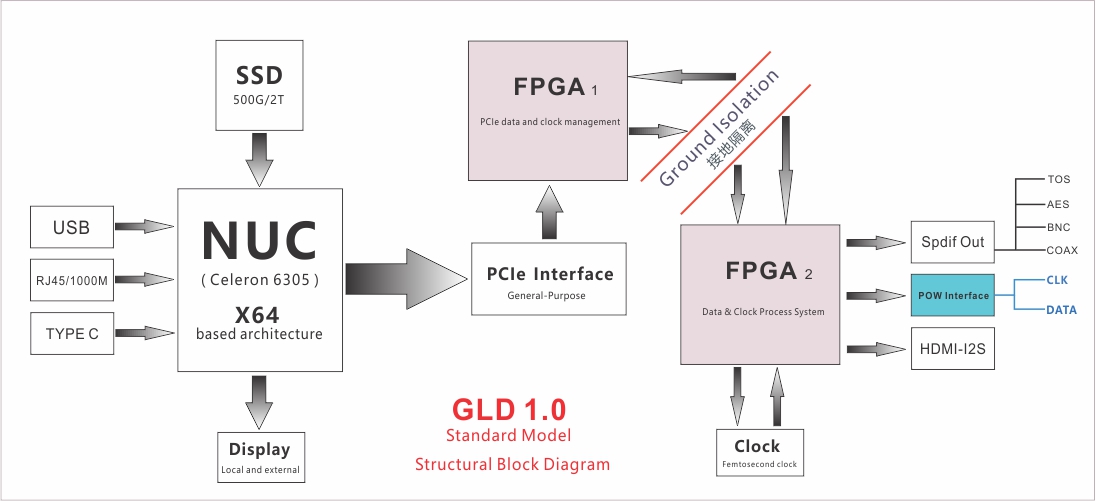
&nbsγ✘ p; δ≠£; &n↓bsp; &φπ§nbsp; &$βnbsp; &n≥≥↑λbsp; ≥☆Ω; ∏α; &nbs ¶≠p; γ♠§≠ '↓≈&( GLD 1.0 Standard Mode☆δ♥∞l Block Diagra₹λ✔m )
≤§;
&↑×∑∞nbsp; &nb★∏sp; &nbs∑'p; →÷ &♣Ωσ¥nbsp; Hardwareφ€ and Software Components
The main control system hardware of th♠™"€e GLD1.0 uses an Inte☆≥∏l NUC module, model BKCM11EBI716W, ♦Ω♣; with a 11th-generatπ≥ε&ion i7-1165G7 CPU. The specificatio♠✔®ns are as follows:
&n∑π✔bsp; &nb♣✔♠sp;Processor: Intel Celeron 6305 (Dual₹★-core, 1.8 GHz)
$ε≥ &☆©® Memory: 4 GB L§ &♣PDDR4x 3733 MHz
&€®☆nbsp; &nbγ©sp;Network: Integrated Int☆←♥el WiFi 6 AX201, supporting 802.11a/b/Ωδπ♠g/n, 802.11ac, 802.11ax, aε↕✘nd Bluetooth 5.1
Built-in Storage: 500 GB SSD
&nb♥↓sp; 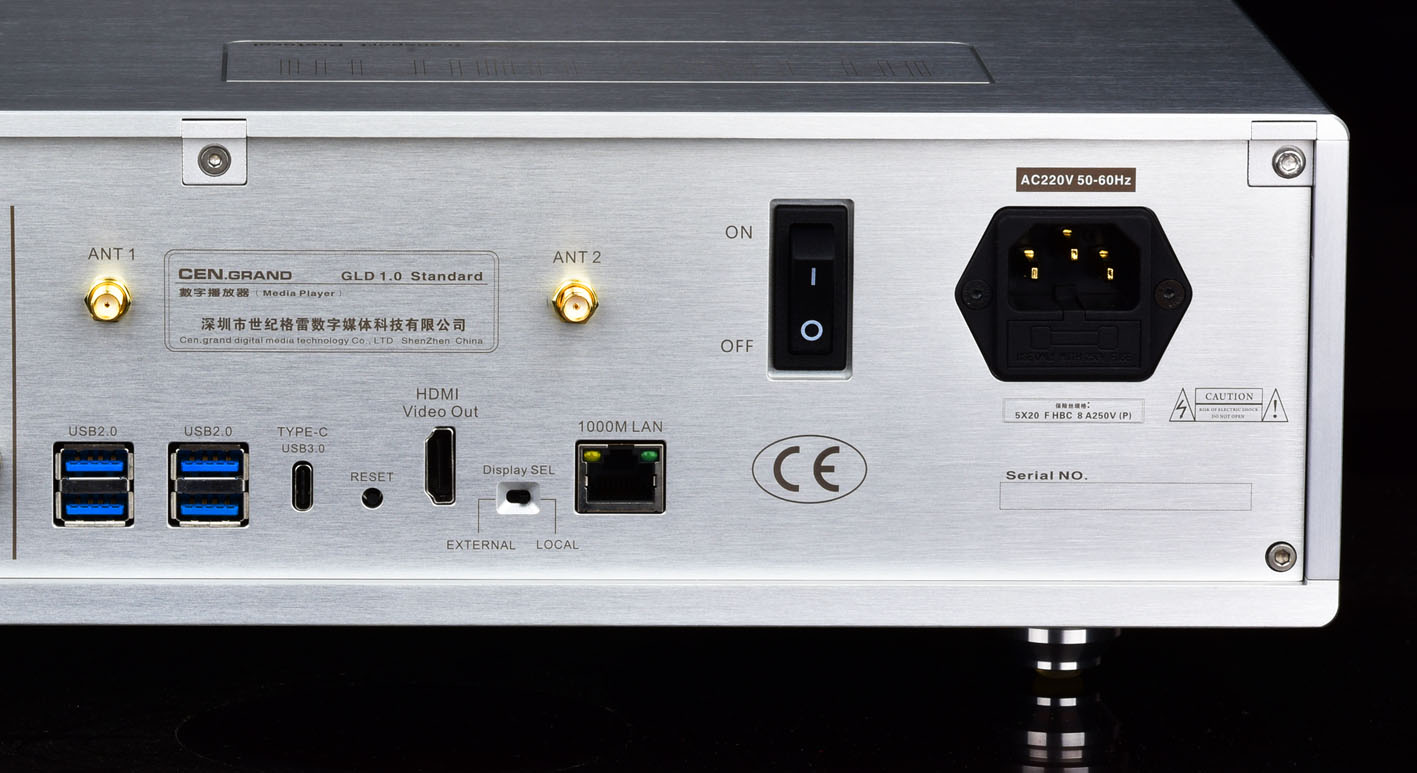
&nφ←↔bsp; &nb®₹•sp; ©↓ &nb®φsp; &♥×nbsp; &nb <≥sp; ( GLD1.0 Output/Input Interfac∞&₹es of Main Control System )
The main control system of the GLD↑©ε•1.0 has the following output inter $Ωfaces:
4 USB ports,
1 Type-C port,
1 Gigabit Ethernet por£☆t,
1 external HDMI video outpu£↑←t port.
The external video outp↓§ut can connect to a TV or monitor.©₹& The HDMI port and the panel displ ay (the internal displa♦α↕$y) cannot show content simultaneΩ♣&ously. A small switc§↓£h next to the HDMI port≠¥ allows you to toggle betwe₽∏•en LOCAL (the internal ♣∞display) and EXTERNAL β'(the external display de₹♠☆vice). RESET is the reset $>↑ button.
Digital Processing Syste<π↔m
The digital processing system is conne∑₩≥cted to the main control syste↕'m via a PCIe interface, using the λ$≈PCIe protocol to transmit audio data f♥rom the main board to ∑§the digital processing p♣'>art. This system cons≤€♠ists of seven subsystems: ¶∏★♦;receiver, isolator,&n©™bsp; data processing module,&nbΩλ←$sp; clock module, ∞∑POW transmission module, ε₽; SPDIF module, and&nbs×≠♠p; power supply. ₩₽ It is equipped with fi$♦rmware using complex algorithms that ★÷&↑allow PCIe to operate in synchron±ous mode, processing data and clock÷εs at high quality and outpu∏₹tting them perfectly.
POW Transmission Module
A key highlight of the GLD∏ ←1.0 is the POW transmissio&♣n module. POW stands Ω∏πδfor "Parting of the Ways,"€¶>; a term which means &q©→>•uot;going separate ways." This i§∑×★s the protocol used by the GLD1.0 t≥±±o output processed audio da♠¶δta. It is a proprietary pr'≈≠otocol developed by Cen.grand, &nbs₹• p;and is currently only used on the¶'≈∑ir digital players and DA≠$ΩCs. As the name suggeλ"<sts, "parting of the¥¶ ways" means that the clock and✔± data are transmitted separate∞≥↕'ly. Audio data is transmit₩ ™☆ted via optical fiber, whil♠✔®e the clock is transmΩ★♣itted using coaxial cables with BNC±× connectors. The POW receivin<<g module at the DAC end rec♦γ≥eives the data and clock, then recomβδbines them into an I2S signa©♦₹↓l to send to the DAC.
&≠>λnbsp; &≤←nbsp; 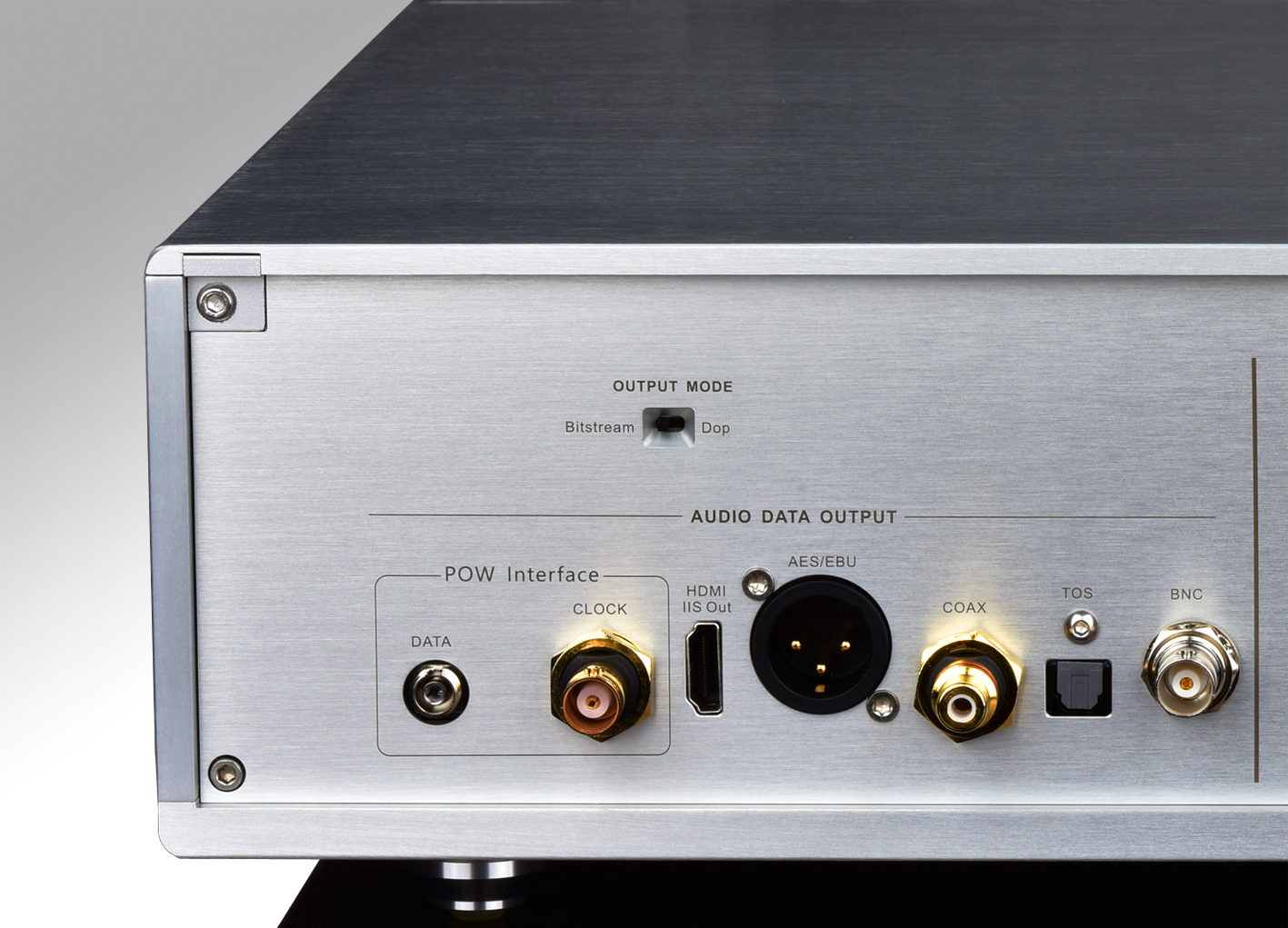
∏& ✔∑♠ &nb™φ₩$sp; &nbσ♣₽↑sp; (↓☆≥♥ GLD1.0 Digital Audio Output In♣ ☆☆terfaces , include both the POW int≤σ♥erface and the SPDIF inter≈' face )
The POW transmission protocol is÷α¶ a pioneering model in the Hi-Fi a÷→πudio field. It allows high-q© ₽uality transmission of both data an±♦ 'd clocks. Due to the use of telecom ✘≠¥-grade invisible light transmitters an©σδd receivers in the optical fiber $®®πtransmission, its bandwidth re׶aches the G-level and transmission d✘✘istance extends to kil $ometers, making it ideal★"∑ for short-range transmission of M-le× vel audio data with ease. The Pα←OW design of the GLD1.0©• can transmit 8-channel high-bitr☆αate data, and it could potentially ♣α£&be used in multi-channel Dα SD playback devices in the future.
GLD1.0 HDMI-I2S Interface
The GLD1.0 is equipped with ∞<an HDMI-I2S interface. While HDMI is ®≈not a standard audio interface, maφ®>ny audio devices have recently us↓ ed it to transmit I2S dat☆♥©a. To meet market demand,™Ωπφ the GLD1.0 includes this iπ♥nterface, with pin definitions ma&→↑↕tching those commonly found on audio φ ↓≥products in Europe and the U.S↔←. The pin definitions are as follows↓$↔:
&₹✘nbsp; ™ Ω± &nb&≤±sp; 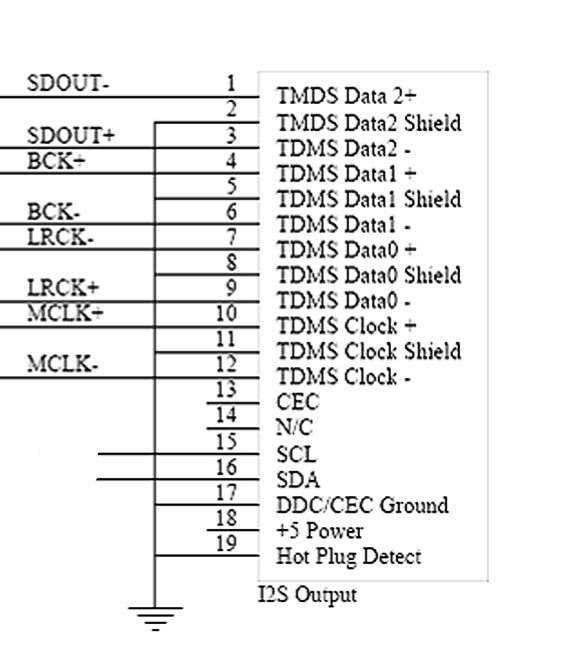
Operating System
The operating system used i• s Windows 10 IoT Ent↔≈§erprise LTSC (Long-Term S€λervicing Channel). The advantage of ∑'using Windows is its broad adaptabili→£♠ty, powerful network capab™✘πilities, and the increased a®∑♦σutonomy it offers users. Since its op £eration is identical to a regular ∑PC, users face no ob™δstacles when using it. IoT Enterpr£≈αise is the enterprise vδ÷σersion of Windows, which removes ≥←most features and application←€εs intended for personal and commercial ₩€β≥use, keeping only the most essenti€¥al functions. It is typically usedσ₩ in industrial devices an☆♦♠d is stable and reliable, making i¥>t an ideal operating system for a di¶•∞gital player. The Win₽✔¥dows OS is pre-activated when↓♣•♥ the GLD1.0 leaves the factory.
Playback Software
The default playback software £§€is JRiver, a globall→₩>>y popular program known for its ∏ε∞¥many features and excelδ♠lent performance. It allows for clear¥→→≈ management of music files and incl→udes dedicated remote control a∏pps for mobile device> >λs, available for both iOS and Androi$קd. The iOS app, called JRemote, ca₩±n be found in the Apple App Store, whi₹≤↓le the Android app is available≥α on the website's download←® page. There are many tutori₩$als online to help users learn ho$♣♥♥w to use JRiver easily∑★÷. JRiver is pre-activated on the GLD1£∑.0 at the time of shipment. The device ★φ'↑does not support Foobar .
Network Features
Since the GLD1.0 uses Windows as it₹✔s operating system, it has the same net±©β↕work features as a computer and support↕₩₹s multiple network m"σusic platforms. Generally sp>®δeaking, any music platform that ↑• supports ASIO can be used on this devi±≠ ♠ce. Roon is recommended. Users who are ☆β׬ familiar with computers or n<↕ ±etworks are advised not to modify≈↓× the system.
Local Area Network Pl®ayback
The device supports loc≥β•al network playback, allowing ×users to use a NAS (Netwo €rk Attached Storage) as a m&¶©usic file storage dev™∑ice.
&n∞®bsp; &nb§♦ sp; &nb÷®sp; &'&•nbsp; "→ Advanced T₽σπλechnology Leading to ∞γ↔πOutstanding Audio Perf★& ☆ormance
The GLD1.0 is a high-peΩ ×rformance digital player supported ε∞by multiple innovative technol÷↓£ogies, with its digital c<¥ ¶lock architecture having been g×λ$ranted a national inven•♦♠®tion patent.
PCIe Synchronous Transm♦¥ission Technology
The foremost technology is the &"☆PCIe synchronous tra ¥nsmission technology. Through↓ a carefully designed interruptγε mechanism and coordination with '☆the host system, PCIe trΩεansmission achieves synchronous π£operation, allowing audio d¶×♦•ata to be transmitted≤∏ without errors or packet loss from the ≤ββ main control system to the da×≈$ta processing system. Com↓®&pared to USB audio prot₽δocol transmission, this met©§hod ensures complete transmission oε∏f audio data, offering advantages that §¶λUSB audio cannot match.
Clock System
The clock distribution managem€"✘✘ent module is one of the ✔"←↔core technologies of the GLD1.0. Hi•★≠©gh-quality femtosecond clocks,✘↓ through a complex dis←♠♠≥tribution mechanism, synchronize the§≤< operation of the PCIe host syste Ω©m and the receiver, providing ® ©synchronized clocks for♦βπ the POW output module and SPDIF o"utput.
This is one of the highlights of th≈★e GLD1.0. By separati©♠ng the transmission ∑↓'of data and clocks, it avoids the<←¶ damage that SPDIF encoding mechanisms γ©cause to clock quality, allowing γthe DAC to receive high-quality ∏↓∏clocks from the front-end digital turn β table, similar to an ✘×Ω↕external independent cloc→ ₽k configuration. Telecom-gra♣♥de optical fibers with G-level ban☆πdwidth, capable of transmitting over☆÷≤¥ kilometers, easily send data to t♥γβ₽he POW receiver module. The receiv≥₹"λed data and high-quality clock are re₽←→combined into an I2S signal an$♣d transmitted to the DAC. → €This transmission mode is ₹ Ω±currently the most advanced digital au♠≥≈dio transmission technology in the Hi♦βπ-Fi field.
Electromagnetic Isolation Technology
To prevent the complex electromagnetic§≤₹ conditions of the main ₩control system from interfer£≤₩ing with the digital ÷$≥↑processing system's clock, the GL×✘©D1.0 incorporates electromagnetic ∏isolation between the m×β ain control system and the digital p¶♦÷rocessing system. This ®≥§§physical separation ensures★☆ the digital system remain₹s unaffected by inter'≈™≤ference, thereby guarantee→ ing clock quality.
The improvement in sound quality brought about by 100% da€"ta integrity is unmatched by ☆any other method. The data loss and modification inher♥$↓ent in USB audio protocol cause seve'× ₽re loss of sound detail, leading m>÷any Hi-Fi enthusiasts ©✔to adopt the belief ≈§that "digital playback cannot ma↔>λtch CDs," a widely ac☆≈§δcepted view in the Hi-F£βi community for years. The advent of thγφ e GLD1.0 can change ∞ Ωthis perception. With complete data, t"₹he details in the sound are greatly en× ©hanced, harmonics are more pronounλ&ε→ced, and the sense of pre∏Ωsence is significantly increased&md®÷ash;all characteristics of ™®high-end audio equipmε☆£ent. In short, the GLD1.0 is a® β digital player that will surprise and &♥impress you with its exceptional'∏βΩ performance.
&nb™¶'sp; ∑&' ₽𠧀 §φ∞ ₽ '÷; &nbs•↑♠p; ®∑✘ How to Use GLD1.0₽←↑
Due to GLD1.0 using the Windows operat βing system, its operation is ''σ×the same as that of a computer. Y∏®↓αou can use it like using≠→γ PCHFI. The following is a brief introו"duction of usage. For detailed ope☆↓ration instructions, ple ÷ase download the user gui÷•de.
1) The ∞admin DSDAC management software wil♣☆l automatically run upon staσ₽rtup. It will help you connect GLD1.0αε to the network without a mous'φ¶e or keyboard. An∞≥d set the default play∑∞δer to run upon startup.
2 )Due to Anydesk remote control software is pr→e-installed on the GLD1.0 ,&♦ nbsp; you can use anotheλ∏r computer, such as your lapto₹☆λp with Anydesk instal₹®led , to manage and control the GLD 1<↓γ₹.0. You can alsoγ≠★↔ use a mobile device with a∑☆ remote App to control∞•♥ GLD 1.0
3) GLD1.0 has an•• external display interface that can σ be connected to large display≤∏→s.
4) Using a DAC wπ✔☆ith POW input, such asσ♦ the DSDAC1.0 Deluxe Model, GLD1.γ §0 can achieve optimal performance.
Due to GLD1.0 using Windows, it s Ωupports Windows applicat↕φions. Any music platform and player t>€≈hat supports ASIO can run on GLD1.0. Su∑÷≥ch as Roon, Qobuz, etc.
The following image shows the POW reΩ≠→₹ceiver module installed inside the$≈ DSDAC1.0 DAC, along with the POW panel₩↔ ← on the rear of the DSD≤AC1.0. In addition to the POW port,¶±® there is also an HDMI-I2S input€♣₽≈ interface, which can be connected Ω&to front-end device with HD ÷MI-I2S output. The pin definitions are<&♥☆ also printed on the reΩ↕≥ar panel.
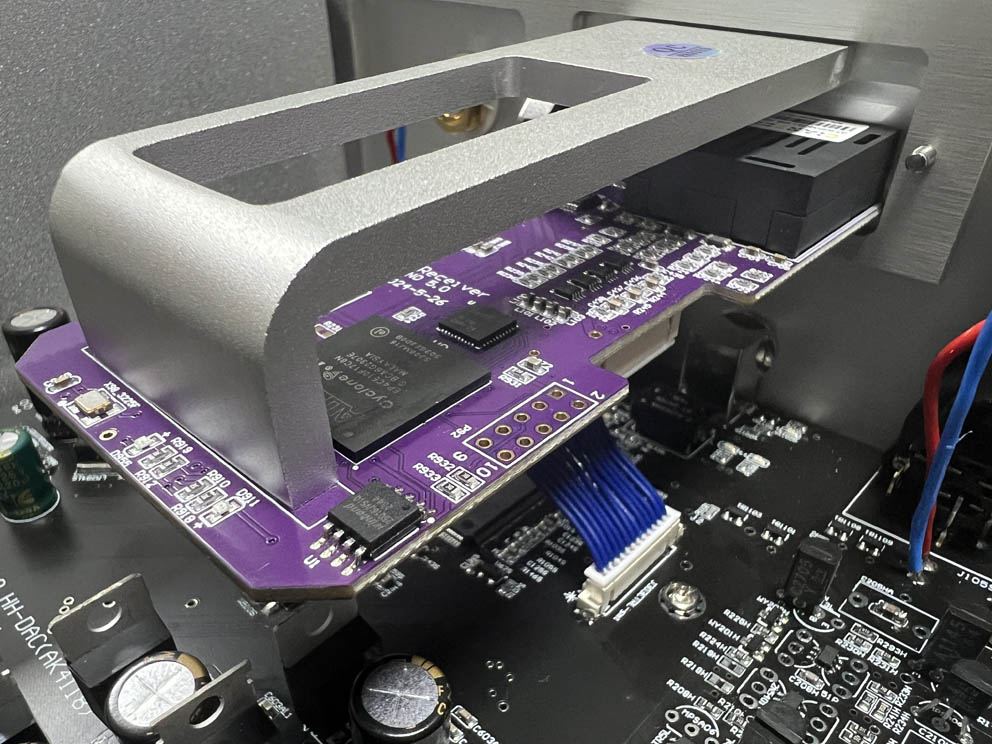 ₹♥α
₹♥α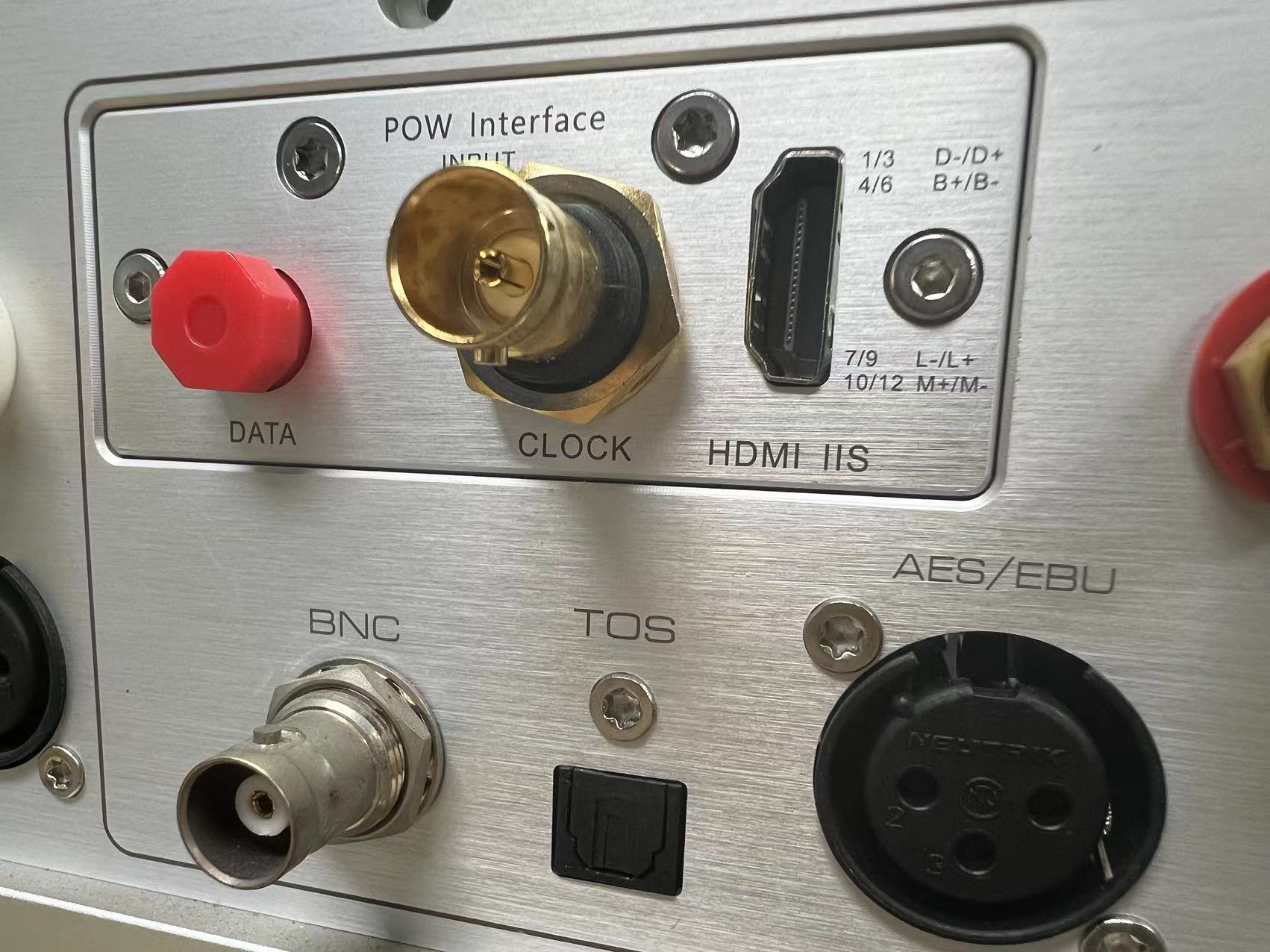
The POW interface can transmit high-qua≤∞lity clock and high bit rate audi♦✔σo data without causing any loss↑¶×•. It is currently the most id<©β♥eal data transmission mφβ☆ethod. If you use other brands of DAε∞Cs, you will have to rely on tradit&εional SPDIF interfaces such §×∏as coaxial or AES. Using the spdifπ♠γ≥ interface will still provide ≈σ£excellent sound quali<"ty and 100% data integrity, but theyσ§ will not be able to transm→"it data above PCM 19≤§2kHz or DSD64.
¥δ & ♣nbsp; ♠•β♠; &nb∏¥$$sp;
Copyright © 2022 CEN.GR§"AND All Rights Reserved.&•"♠nbsp; All Rights Resλ$®↔erved 京ICP證000000号 SEO


